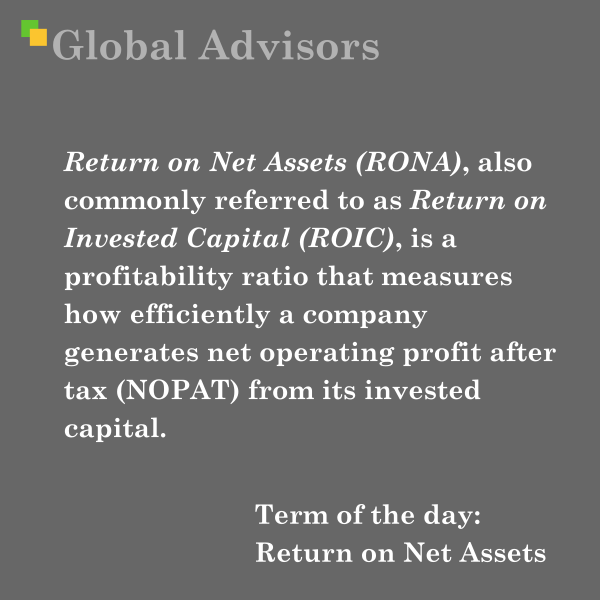Return on Net Assets (RONA), also commonly referred to as Return on Invested Capital (ROIC), is a profitability ratio that measures how efficiently a company generates net operating profit after tax (NOPAT) from its invested capital. The typical formula is:
RONA (or ROIC) = NOPAT ÷ Invested Capital
where invested capital is defined as fixed assets plus net working capital.
This metric assesses the return a business earns on the capital allocated to its core operations, excluding the effect of financial leverage and non-operating items. NOPAT is used as it reflects the after-tax profits generated purely from operations, providing a cleaner view of value creation for all providers of capital. Invested capital focuses on assets directly tied to operational performance: fixed assets such as property, plant and equipment, and net working capital (current operating assets less current operating liabilities). This construction ensures the measure remains aligned with how capital is deployed within the firm.
RONA/ROIC enables investors, managers, and analysts to judge whether a company is generating returns above its cost of capital—a key determinant of value creation and strategic advantage. The ratio also acts as a benchmark for performance improvement and capital allocation decisions.
Arguments for Using RONA/ROIC
- Comprehensive Operational Measurement: As it focuses on NOPAT and invested capital, it reflects returns from the actual deployment of resources, independent of capital structure or accounting artefacts.
- Alignment with Value Creation: ROIC is a foundational building block in value-based management, reliably indicating whether growth creates or destroys shareholder value. Returns above the cost of capital are indicative of a firm’s competitive advantage and its ability to reinvest profitably.
- Benchmarking Capability: This measure enables robust comparison of performance across industries, companies, and geographies, particularly where capital intensity varies significantly.
- Management Discipline: Emphasising RONA/ROIC encourages effective capital allocation and ongoing scrutiny of operational efficiency, discouraging unproductive investment.
Criticisms and Limitations
- Potential for Manipulation: Definitions of invested capital and NOPAT can vary between organisations. Differences in accounting policies (e.g., capitalisation vs expensing, asset write-downs) may distort comparisons.
- Ignores Future Investment Needs: As a static measure, RONA/ROIC reflects past or current performance, not the changing investment requirements or growth opportunities facing a business.
- May Penalise Growth: High growth companies with significant recent capital expenditure may report lower RONA/ROIC, even if those investments will yield future returns.
- Industry Differences: Utility is often highest in mature businesses—RONA/ROIC may be less relevant or comparable for asset-light or intangible-driven business models.
Leading Theorists and Strategic Foundations
Aswath Damodaran and the authors of Valuation: Measuring and Managing the Value of Companies—Tim Koller, Marc Goedhart, and David Wessels—are directly associated with the development, articulation, and scholarly propagation of concepts like RONA and ROIC.
Tim Koller, Marc Goedhart, and David Wessels
As co-authors of the definitive text Valuation: Measuring and Managing the Value of Companies (first published in 1990, now in its 7th edition), Koller, Goedhart, and Wessels have provided the most detailed and widely adopted frameworks for calculating, interpreting, and applying ROIC in both academic and practitioner circles.
Their work systematised the relationship between ROIC, cost of capital, and value creation, embedding this metric at the heart of modern strategic finance and value-based management. They emphasise that only companies able to sustain ROIC above their cost of capital create lasting economic value, and their approach is rigorous in ensuring clarity of calculation (advocating NOPAT and properly defined invested capital for consistency and comparability). Their text is canonical in both MBA programmes and leading advisory practices, widely referenced in strategic due diligence, private equity, and long-term corporate planning.
Aswath Damodaran
Aswath Damodaran, Professor of Finance at the NYU Stern School of Business, is another seminal figure. His textbooks, including Investment Valuation and Damodaran on Valuation, champion the use of ROIC as a core measure of company performance. Damodaran’s extensive public lectures, datasets, and analytical frameworks stress the importance of analysing returns on invested capital and understanding how this interacts with growth and risk in both investment analysis and strategic decision-making.
Damodaran’s work is highly practical, meticulously clarifying issues in the calculation and interpretation of ROIC, especially around treatment of operating leases, goodwill, and intangibles, and highlighting the complexities that confront both value investors and boards. His influence is broad, with his online resources and publications serving as go-to technical references for professionals and academics alike.
Both Damodaran and the Valuation authors are credited with shaping the field’s understanding of RONA/ROIC’s strategic implications and embedding this measure at the core of value-driven management and investment strategy.



